Breastfeeding, Overweight, and Child Development: A Research Study
VerifiedAdded on 2021/04/17
|27
|5385
|261
Report
AI Summary
This research report investigates the statistical relationship between breastfeeding and overweight in children. The study explores the impact of breastfeeding duration on child development and nutrition, utilizing both descriptive and quantitative research designs. The methodology includes surveys, observations, and measurements to collect data from children and their parents. Statistical analysis, employing one-sample t-tests and one-way ANOVA, is used to determine the significance of breastfeeding on children's BMI and the extent to which lack of breastfeeding contributes to overweight. The report aims to highlight the importance of breastfeeding practices and their long-term effects on child health, contributing to a better understanding of the issue and providing insights for parents and healthcare professionals. Findings are presented in tables, charts, and discussions, with a focus on the statistical significance of the relationship between breastfeeding and overweight.
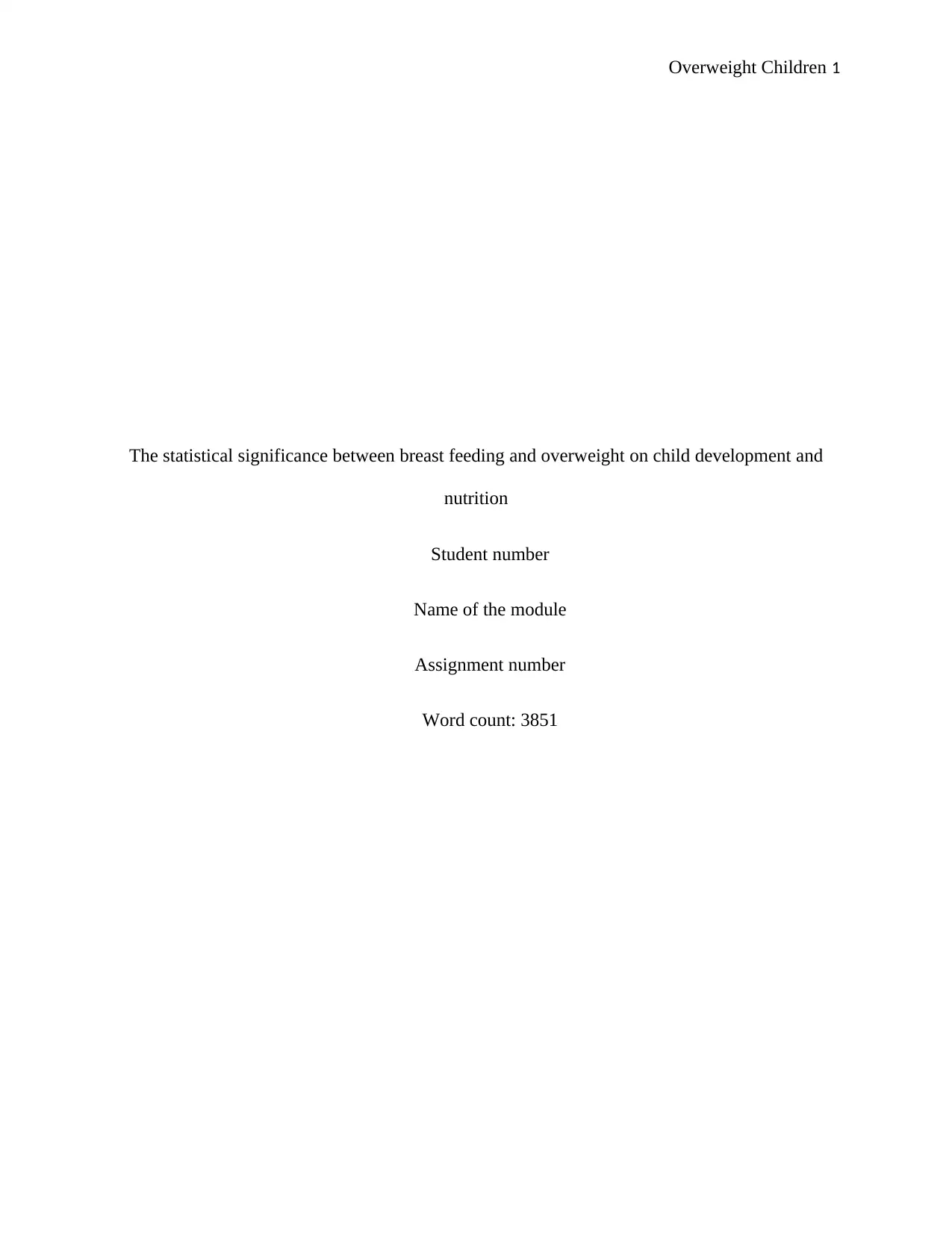
Overweight Children 1
The statistical significance between breast feeding and overweight on child development and
nutrition
Student number
Name of the module
Assignment number
Word count: 3851
The statistical significance between breast feeding and overweight on child development and
nutrition
Student number
Name of the module
Assignment number
Word count: 3851
Paraphrase This Document
Need a fresh take? Get an instant paraphrase of this document with our AI Paraphraser
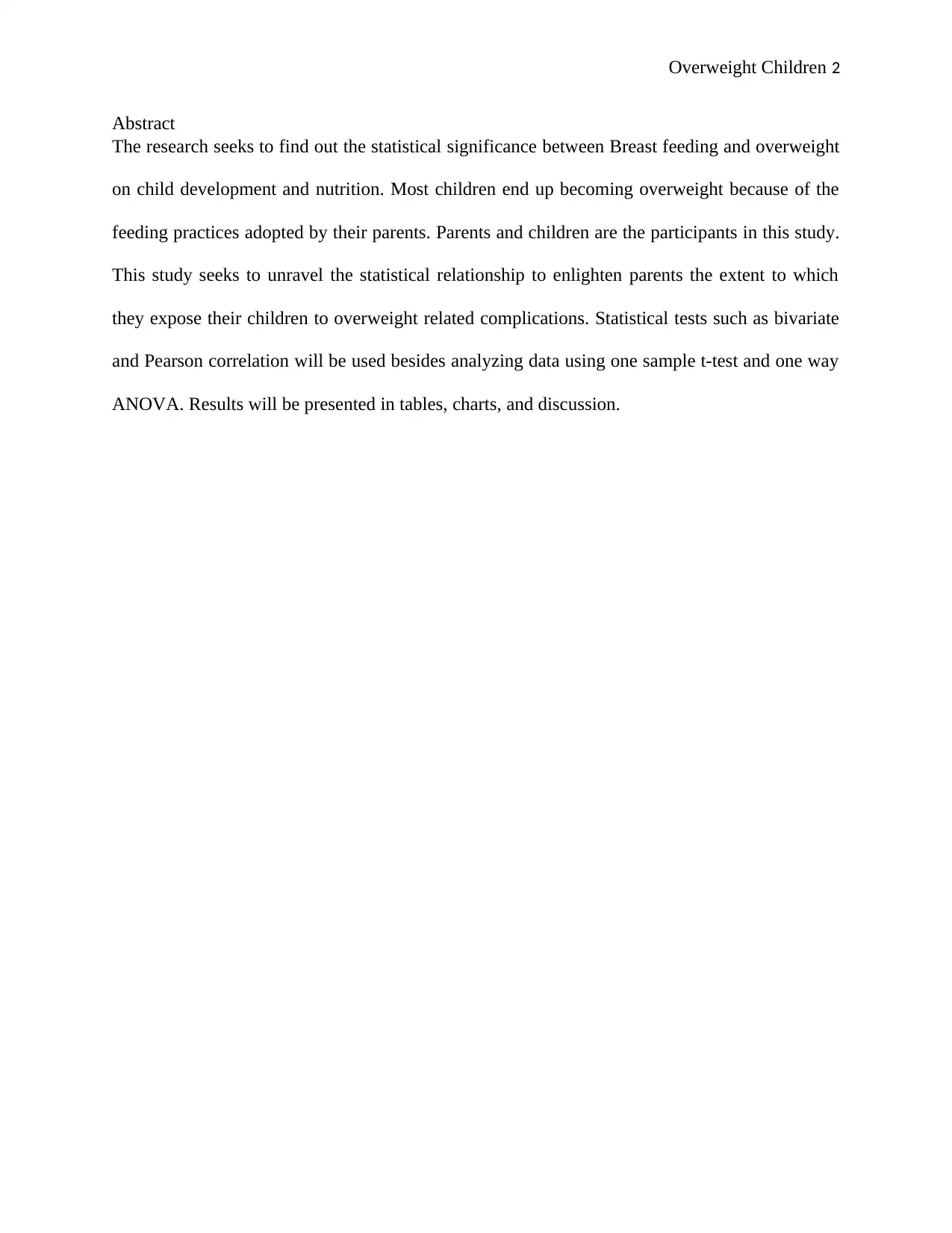
Overweight Children 2
Abstract
The research seeks to find out the statistical significance between Breast feeding and overweight
on child development and nutrition. Most children end up becoming overweight because of the
feeding practices adopted by their parents. Parents and children are the participants in this study.
This study seeks to unravel the statistical relationship to enlighten parents the extent to which
they expose their children to overweight related complications. Statistical tests such as bivariate
and Pearson correlation will be used besides analyzing data using one sample t-test and one way
ANOVA. Results will be presented in tables, charts, and discussion.
Abstract
The research seeks to find out the statistical significance between Breast feeding and overweight
on child development and nutrition. Most children end up becoming overweight because of the
feeding practices adopted by their parents. Parents and children are the participants in this study.
This study seeks to unravel the statistical relationship to enlighten parents the extent to which
they expose their children to overweight related complications. Statistical tests such as bivariate
and Pearson correlation will be used besides analyzing data using one sample t-test and one way
ANOVA. Results will be presented in tables, charts, and discussion.
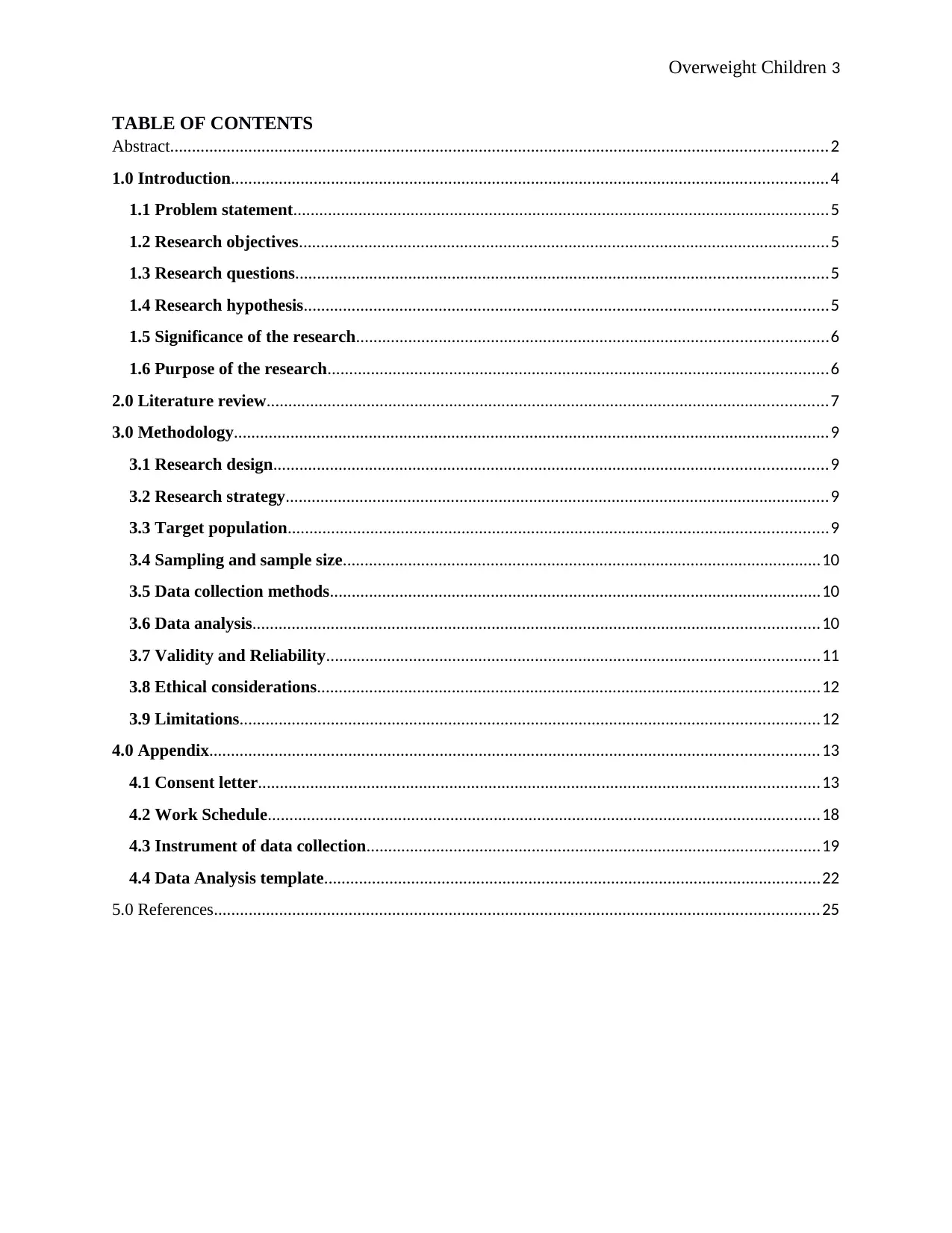
Overweight Children 3
TABLE OF CONTENTS
Abstract.......................................................................................................................................................2
1.0 Introduction.........................................................................................................................................4
1.1 Problem statement...........................................................................................................................5
1.2 Research objectives..........................................................................................................................5
1.3 Research questions..........................................................................................................................5
1.4 Research hypothesis........................................................................................................................5
1.5 Significance of the research............................................................................................................6
1.6 Purpose of the research...................................................................................................................6
2.0 Literature review.................................................................................................................................7
3.0 Methodology.........................................................................................................................................9
3.1 Research design...............................................................................................................................9
3.2 Research strategy.............................................................................................................................9
3.3 Target population............................................................................................................................9
3.4 Sampling and sample size..............................................................................................................10
3.5 Data collection methods.................................................................................................................10
3.6 Data analysis..................................................................................................................................10
3.7 Validity and Reliability.................................................................................................................11
3.8 Ethical considerations...................................................................................................................12
3.9 Limitations.....................................................................................................................................12
4.0 Appendix............................................................................................................................................13
4.1 Consent letter.................................................................................................................................13
4.2 Work Schedule...............................................................................................................................18
4.3 Instrument of data collection........................................................................................................19
4.4 Data Analysis template..................................................................................................................22
5.0 References...........................................................................................................................................25
TABLE OF CONTENTS
Abstract.......................................................................................................................................................2
1.0 Introduction.........................................................................................................................................4
1.1 Problem statement...........................................................................................................................5
1.2 Research objectives..........................................................................................................................5
1.3 Research questions..........................................................................................................................5
1.4 Research hypothesis........................................................................................................................5
1.5 Significance of the research............................................................................................................6
1.6 Purpose of the research...................................................................................................................6
2.0 Literature review.................................................................................................................................7
3.0 Methodology.........................................................................................................................................9
3.1 Research design...............................................................................................................................9
3.2 Research strategy.............................................................................................................................9
3.3 Target population............................................................................................................................9
3.4 Sampling and sample size..............................................................................................................10
3.5 Data collection methods.................................................................................................................10
3.6 Data analysis..................................................................................................................................10
3.7 Validity and Reliability.................................................................................................................11
3.8 Ethical considerations...................................................................................................................12
3.9 Limitations.....................................................................................................................................12
4.0 Appendix............................................................................................................................................13
4.1 Consent letter.................................................................................................................................13
4.2 Work Schedule...............................................................................................................................18
4.3 Instrument of data collection........................................................................................................19
4.4 Data Analysis template..................................................................................................................22
5.0 References...........................................................................................................................................25
⊘ This is a preview!⊘
Do you want full access?
Subscribe today to unlock all pages.

Trusted by 1+ million students worldwide
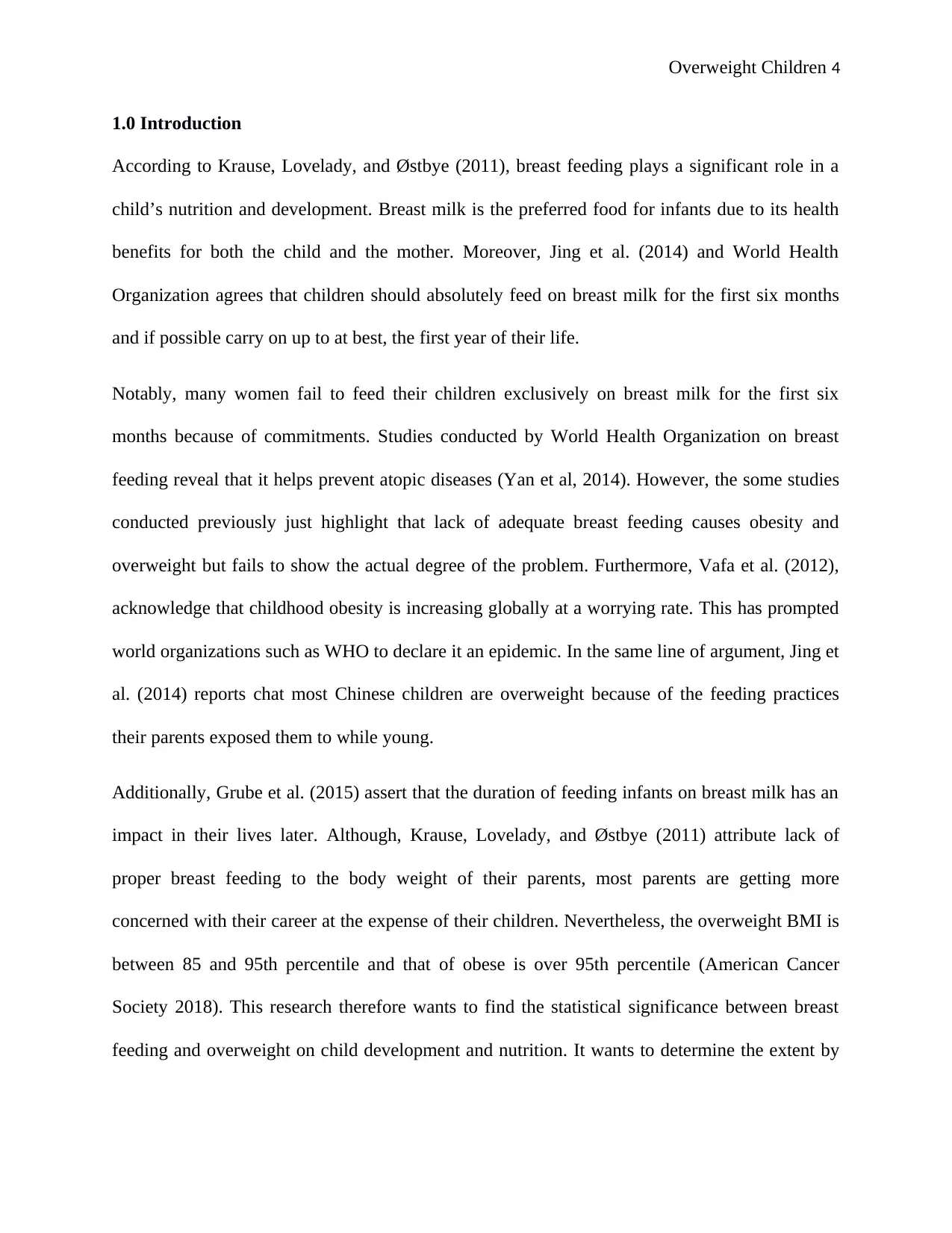
Overweight Children 4
1.0 Introduction
According to Krause, Lovelady, and Østbye (2011), breast feeding plays a significant role in a
child’s nutrition and development. Breast milk is the preferred food for infants due to its health
benefits for both the child and the mother. Moreover, Jing et al. (2014) and World Health
Organization agrees that children should absolutely feed on breast milk for the first six months
and if possible carry on up to at best, the first year of their life.
Notably, many women fail to feed their children exclusively on breast milk for the first six
months because of commitments. Studies conducted by World Health Organization on breast
feeding reveal that it helps prevent atopic diseases (Yan et al, 2014). However, the some studies
conducted previously just highlight that lack of adequate breast feeding causes obesity and
overweight but fails to show the actual degree of the problem. Furthermore, Vafa et al. (2012),
acknowledge that childhood obesity is increasing globally at a worrying rate. This has prompted
world organizations such as WHO to declare it an epidemic. In the same line of argument, Jing et
al. (2014) reports chat most Chinese children are overweight because of the feeding practices
their parents exposed them to while young.
Additionally, Grube et al. (2015) assert that the duration of feeding infants on breast milk has an
impact in their lives later. Although, Krause, Lovelady, and Østbye (2011) attribute lack of
proper breast feeding to the body weight of their parents, most parents are getting more
concerned with their career at the expense of their children. Nevertheless, the overweight BMI is
between 85 and 95th percentile and that of obese is over 95th percentile (American Cancer
Society 2018). This research therefore wants to find the statistical significance between breast
feeding and overweight on child development and nutrition. It wants to determine the extent by
1.0 Introduction
According to Krause, Lovelady, and Østbye (2011), breast feeding plays a significant role in a
child’s nutrition and development. Breast milk is the preferred food for infants due to its health
benefits for both the child and the mother. Moreover, Jing et al. (2014) and World Health
Organization agrees that children should absolutely feed on breast milk for the first six months
and if possible carry on up to at best, the first year of their life.
Notably, many women fail to feed their children exclusively on breast milk for the first six
months because of commitments. Studies conducted by World Health Organization on breast
feeding reveal that it helps prevent atopic diseases (Yan et al, 2014). However, the some studies
conducted previously just highlight that lack of adequate breast feeding causes obesity and
overweight but fails to show the actual degree of the problem. Furthermore, Vafa et al. (2012),
acknowledge that childhood obesity is increasing globally at a worrying rate. This has prompted
world organizations such as WHO to declare it an epidemic. In the same line of argument, Jing et
al. (2014) reports chat most Chinese children are overweight because of the feeding practices
their parents exposed them to while young.
Additionally, Grube et al. (2015) assert that the duration of feeding infants on breast milk has an
impact in their lives later. Although, Krause, Lovelady, and Østbye (2011) attribute lack of
proper breast feeding to the body weight of their parents, most parents are getting more
concerned with their career at the expense of their children. Nevertheless, the overweight BMI is
between 85 and 95th percentile and that of obese is over 95th percentile (American Cancer
Society 2018). This research therefore wants to find the statistical significance between breast
feeding and overweight on child development and nutrition. It wants to determine the extent by
Paraphrase This Document
Need a fresh take? Get an instant paraphrase of this document with our AI Paraphraser
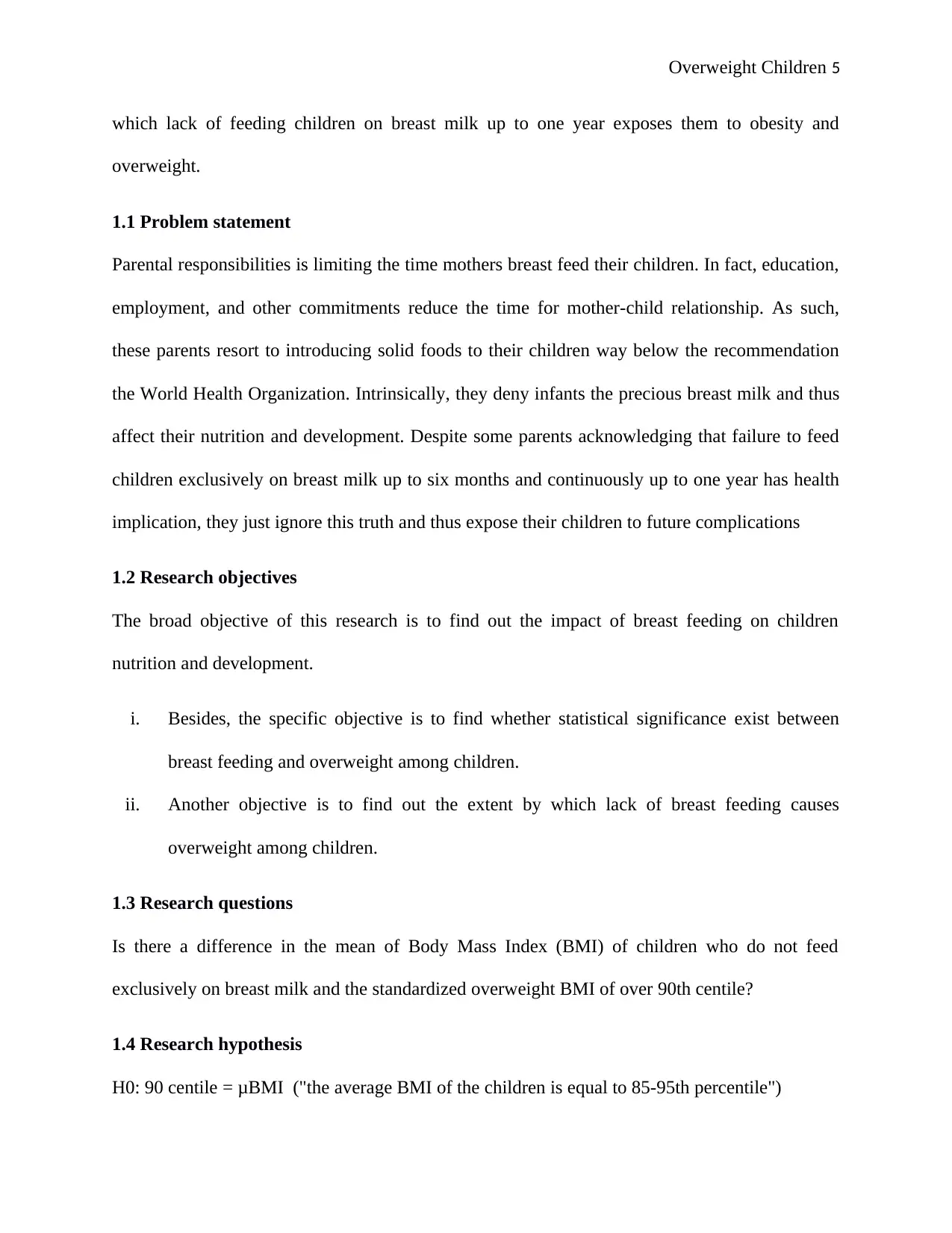
Overweight Children 5
which lack of feeding children on breast milk up to one year exposes them to obesity and
overweight.
1.1 Problem statement
Parental responsibilities is limiting the time mothers breast feed their children. In fact, education,
employment, and other commitments reduce the time for mother-child relationship. As such,
these parents resort to introducing solid foods to their children way below the recommendation
the World Health Organization. Intrinsically, they deny infants the precious breast milk and thus
affect their nutrition and development. Despite some parents acknowledging that failure to feed
children exclusively on breast milk up to six months and continuously up to one year has health
implication, they just ignore this truth and thus expose their children to future complications
1.2 Research objectives
The broad objective of this research is to find out the impact of breast feeding on children
nutrition and development.
i. Besides, the specific objective is to find whether statistical significance exist between
breast feeding and overweight among children.
ii. Another objective is to find out the extent by which lack of breast feeding causes
overweight among children.
1.3 Research questions
Is there a difference in the mean of Body Mass Index (BMI) of children who do not feed
exclusively on breast milk and the standardized overweight BMI of over 90th centile?
1.4 Research hypothesis
H0: 90 centile = μBMI ("the average BMI of the children is equal to 85-95th percentile")
which lack of feeding children on breast milk up to one year exposes them to obesity and
overweight.
1.1 Problem statement
Parental responsibilities is limiting the time mothers breast feed their children. In fact, education,
employment, and other commitments reduce the time for mother-child relationship. As such,
these parents resort to introducing solid foods to their children way below the recommendation
the World Health Organization. Intrinsically, they deny infants the precious breast milk and thus
affect their nutrition and development. Despite some parents acknowledging that failure to feed
children exclusively on breast milk up to six months and continuously up to one year has health
implication, they just ignore this truth and thus expose their children to future complications
1.2 Research objectives
The broad objective of this research is to find out the impact of breast feeding on children
nutrition and development.
i. Besides, the specific objective is to find whether statistical significance exist between
breast feeding and overweight among children.
ii. Another objective is to find out the extent by which lack of breast feeding causes
overweight among children.
1.3 Research questions
Is there a difference in the mean of Body Mass Index (BMI) of children who do not feed
exclusively on breast milk and the standardized overweight BMI of over 90th centile?
1.4 Research hypothesis
H0: 90 centile = μBMI ("the average BMI of the children is equal to 85-95th percentile")
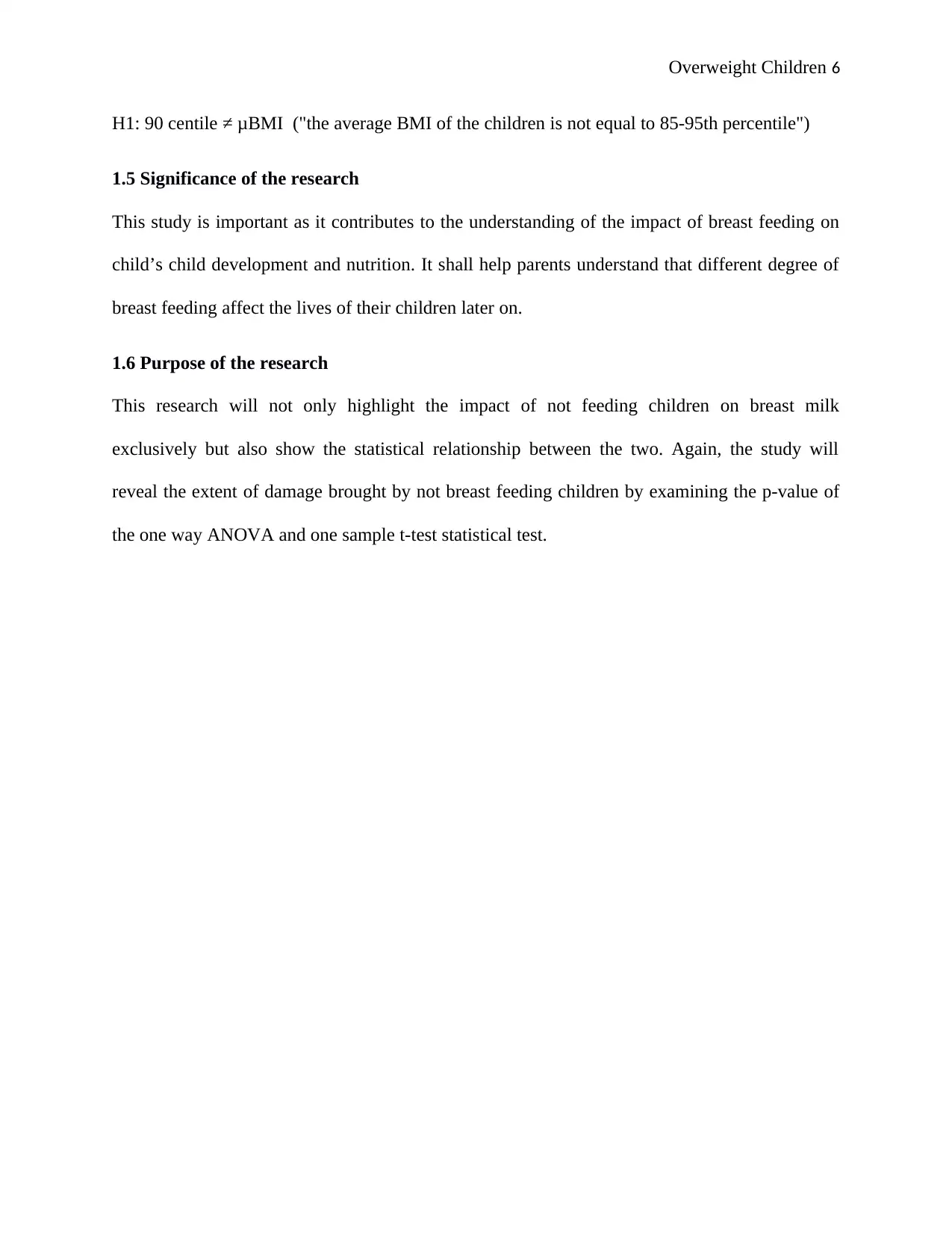
Overweight Children 6
H1: 90 centile ≠ μBMI ("the average BMI of the children is not equal to 85-95th percentile")
1.5 Significance of the research
This study is important as it contributes to the understanding of the impact of breast feeding on
child’s child development and nutrition. It shall help parents understand that different degree of
breast feeding affect the lives of their children later on.
1.6 Purpose of the research
This research will not only highlight the impact of not feeding children on breast milk
exclusively but also show the statistical relationship between the two. Again, the study will
reveal the extent of damage brought by not breast feeding children by examining the p-value of
the one way ANOVA and one sample t-test statistical test.
H1: 90 centile ≠ μBMI ("the average BMI of the children is not equal to 85-95th percentile")
1.5 Significance of the research
This study is important as it contributes to the understanding of the impact of breast feeding on
child’s child development and nutrition. It shall help parents understand that different degree of
breast feeding affect the lives of their children later on.
1.6 Purpose of the research
This research will not only highlight the impact of not feeding children on breast milk
exclusively but also show the statistical relationship between the two. Again, the study will
reveal the extent of damage brought by not breast feeding children by examining the p-value of
the one way ANOVA and one sample t-test statistical test.
⊘ This is a preview!⊘
Do you want full access?
Subscribe today to unlock all pages.

Trusted by 1+ million students worldwide
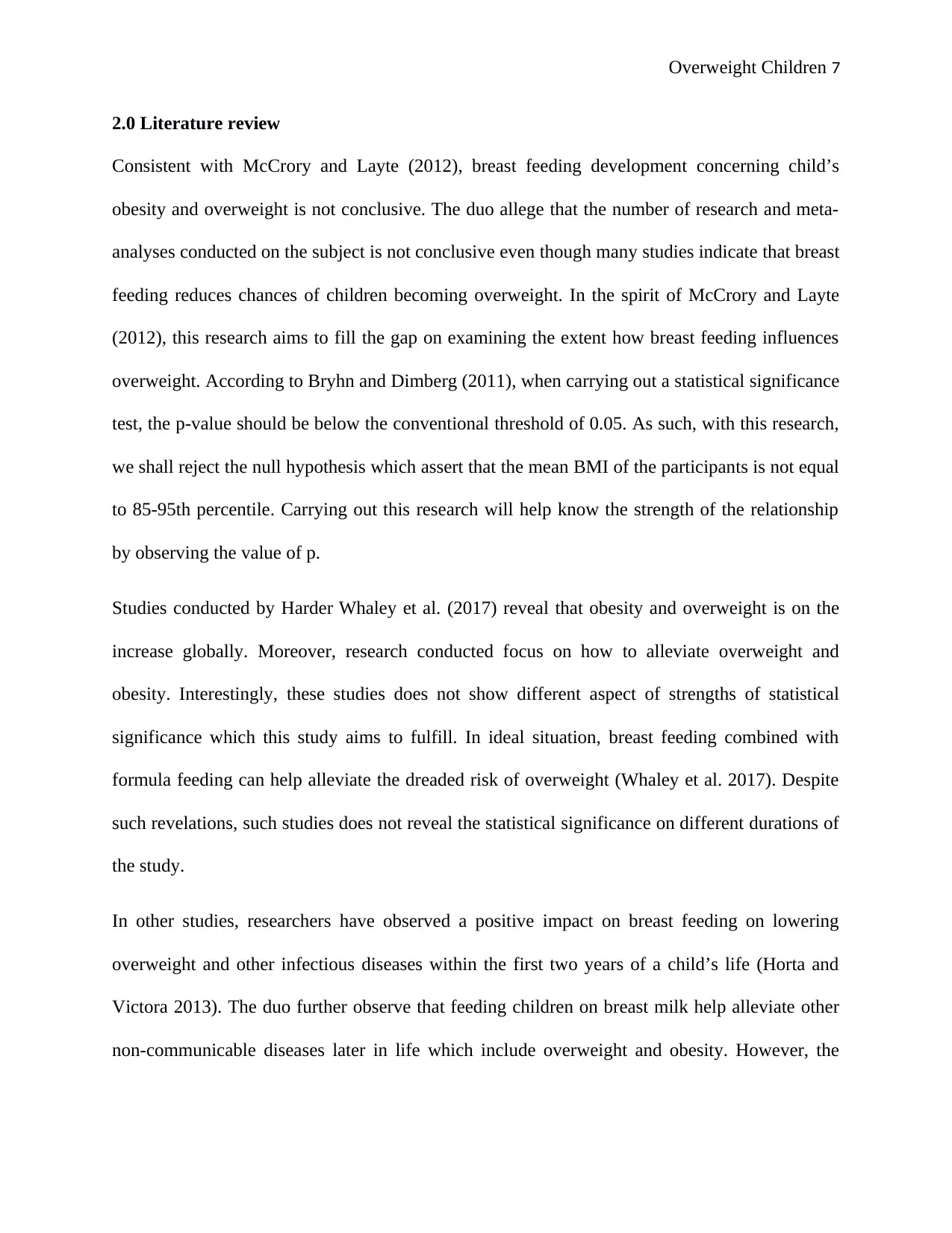
Overweight Children 7
2.0 Literature review
Consistent with McCrory and Layte (2012), breast feeding development concerning child’s
obesity and overweight is not conclusive. The duo allege that the number of research and meta-
analyses conducted on the subject is not conclusive even though many studies indicate that breast
feeding reduces chances of children becoming overweight. In the spirit of McCrory and Layte
(2012), this research aims to fill the gap on examining the extent how breast feeding influences
overweight. According to Bryhn and Dimberg (2011), when carrying out a statistical significance
test, the p-value should be below the conventional threshold of 0.05. As such, with this research,
we shall reject the null hypothesis which assert that the mean BMI of the participants is not equal
to 85-95th percentile. Carrying out this research will help know the strength of the relationship
by observing the value of p.
Studies conducted by Harder Whaley et al. (2017) reveal that obesity and overweight is on the
increase globally. Moreover, research conducted focus on how to alleviate overweight and
obesity. Interestingly, these studies does not show different aspect of strengths of statistical
significance which this study aims to fulfill. In ideal situation, breast feeding combined with
formula feeding can help alleviate the dreaded risk of overweight (Whaley et al. 2017). Despite
such revelations, such studies does not reveal the statistical significance on different durations of
the study.
In other studies, researchers have observed a positive impact on breast feeding on lowering
overweight and other infectious diseases within the first two years of a child’s life (Horta and
Victora 2013). The duo further observe that feeding children on breast milk help alleviate other
non-communicable diseases later in life which include overweight and obesity. However, the
2.0 Literature review
Consistent with McCrory and Layte (2012), breast feeding development concerning child’s
obesity and overweight is not conclusive. The duo allege that the number of research and meta-
analyses conducted on the subject is not conclusive even though many studies indicate that breast
feeding reduces chances of children becoming overweight. In the spirit of McCrory and Layte
(2012), this research aims to fill the gap on examining the extent how breast feeding influences
overweight. According to Bryhn and Dimberg (2011), when carrying out a statistical significance
test, the p-value should be below the conventional threshold of 0.05. As such, with this research,
we shall reject the null hypothesis which assert that the mean BMI of the participants is not equal
to 85-95th percentile. Carrying out this research will help know the strength of the relationship
by observing the value of p.
Studies conducted by Harder Whaley et al. (2017) reveal that obesity and overweight is on the
increase globally. Moreover, research conducted focus on how to alleviate overweight and
obesity. Interestingly, these studies does not show different aspect of strengths of statistical
significance which this study aims to fulfill. In ideal situation, breast feeding combined with
formula feeding can help alleviate the dreaded risk of overweight (Whaley et al. 2017). Despite
such revelations, such studies does not reveal the statistical significance on different durations of
the study.
In other studies, researchers have observed a positive impact on breast feeding on lowering
overweight and other infectious diseases within the first two years of a child’s life (Horta and
Victora 2013). The duo further observe that feeding children on breast milk help alleviate other
non-communicable diseases later in life which include overweight and obesity. However, the
Paraphrase This Document
Need a fresh take? Get an instant paraphrase of this document with our AI Paraphraser
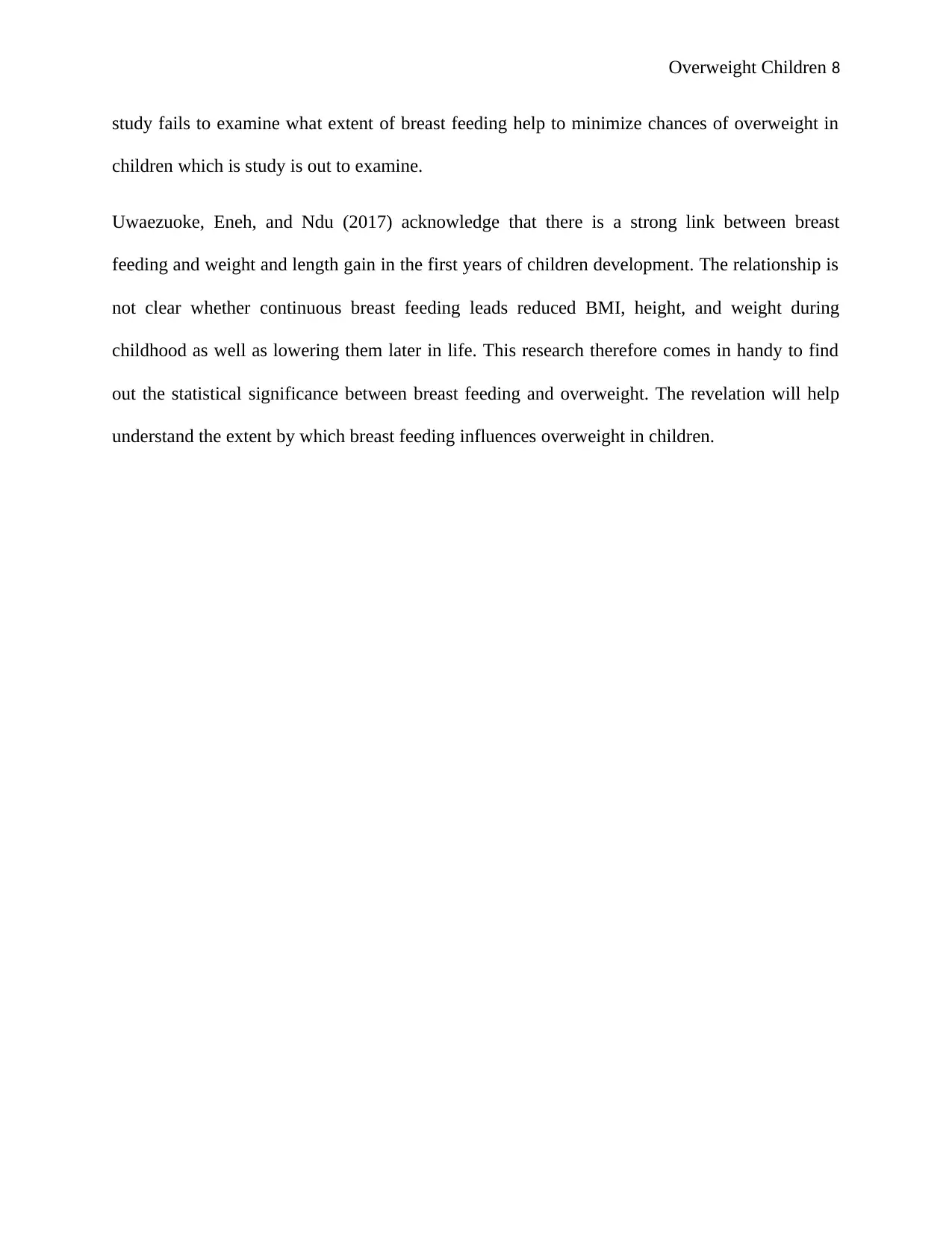
Overweight Children 8
study fails to examine what extent of breast feeding help to minimize chances of overweight in
children which is study is out to examine.
Uwaezuoke, Eneh, and Ndu (2017) acknowledge that there is a strong link between breast
feeding and weight and length gain in the first years of children development. The relationship is
not clear whether continuous breast feeding leads reduced BMI, height, and weight during
childhood as well as lowering them later in life. This research therefore comes in handy to find
out the statistical significance between breast feeding and overweight. The revelation will help
understand the extent by which breast feeding influences overweight in children.
study fails to examine what extent of breast feeding help to minimize chances of overweight in
children which is study is out to examine.
Uwaezuoke, Eneh, and Ndu (2017) acknowledge that there is a strong link between breast
feeding and weight and length gain in the first years of children development. The relationship is
not clear whether continuous breast feeding leads reduced BMI, height, and weight during
childhood as well as lowering them later in life. This research therefore comes in handy to find
out the statistical significance between breast feeding and overweight. The revelation will help
understand the extent by which breast feeding influences overweight in children.
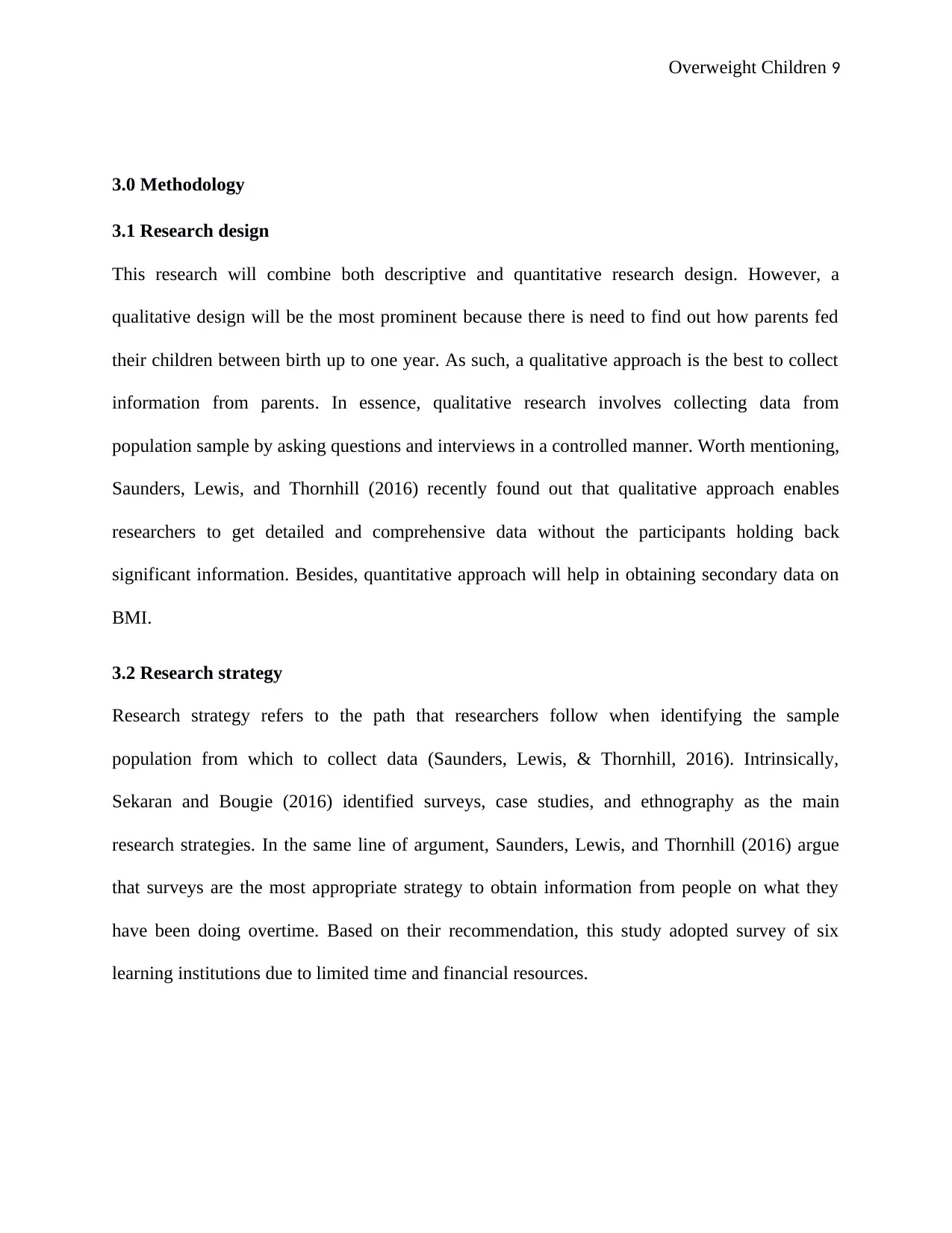
Overweight Children 9
3.0 Methodology
3.1 Research design
This research will combine both descriptive and quantitative research design. However, a
qualitative design will be the most prominent because there is need to find out how parents fed
their children between birth up to one year. As such, a qualitative approach is the best to collect
information from parents. In essence, qualitative research involves collecting data from
population sample by asking questions and interviews in a controlled manner. Worth mentioning,
Saunders, Lewis, and Thornhill (2016) recently found out that qualitative approach enables
researchers to get detailed and comprehensive data without the participants holding back
significant information. Besides, quantitative approach will help in obtaining secondary data on
BMI.
3.2 Research strategy
Research strategy refers to the path that researchers follow when identifying the sample
population from which to collect data (Saunders, Lewis, & Thornhill, 2016). Intrinsically,
Sekaran and Bougie (2016) identified surveys, case studies, and ethnography as the main
research strategies. In the same line of argument, Saunders, Lewis, and Thornhill (2016) argue
that surveys are the most appropriate strategy to obtain information from people on what they
have been doing overtime. Based on their recommendation, this study adopted survey of six
learning institutions due to limited time and financial resources.
3.0 Methodology
3.1 Research design
This research will combine both descriptive and quantitative research design. However, a
qualitative design will be the most prominent because there is need to find out how parents fed
their children between birth up to one year. As such, a qualitative approach is the best to collect
information from parents. In essence, qualitative research involves collecting data from
population sample by asking questions and interviews in a controlled manner. Worth mentioning,
Saunders, Lewis, and Thornhill (2016) recently found out that qualitative approach enables
researchers to get detailed and comprehensive data without the participants holding back
significant information. Besides, quantitative approach will help in obtaining secondary data on
BMI.
3.2 Research strategy
Research strategy refers to the path that researchers follow when identifying the sample
population from which to collect data (Saunders, Lewis, & Thornhill, 2016). Intrinsically,
Sekaran and Bougie (2016) identified surveys, case studies, and ethnography as the main
research strategies. In the same line of argument, Saunders, Lewis, and Thornhill (2016) argue
that surveys are the most appropriate strategy to obtain information from people on what they
have been doing overtime. Based on their recommendation, this study adopted survey of six
learning institutions due to limited time and financial resources.
⊘ This is a preview!⊘
Do you want full access?
Subscribe today to unlock all pages.

Trusted by 1+ million students worldwide
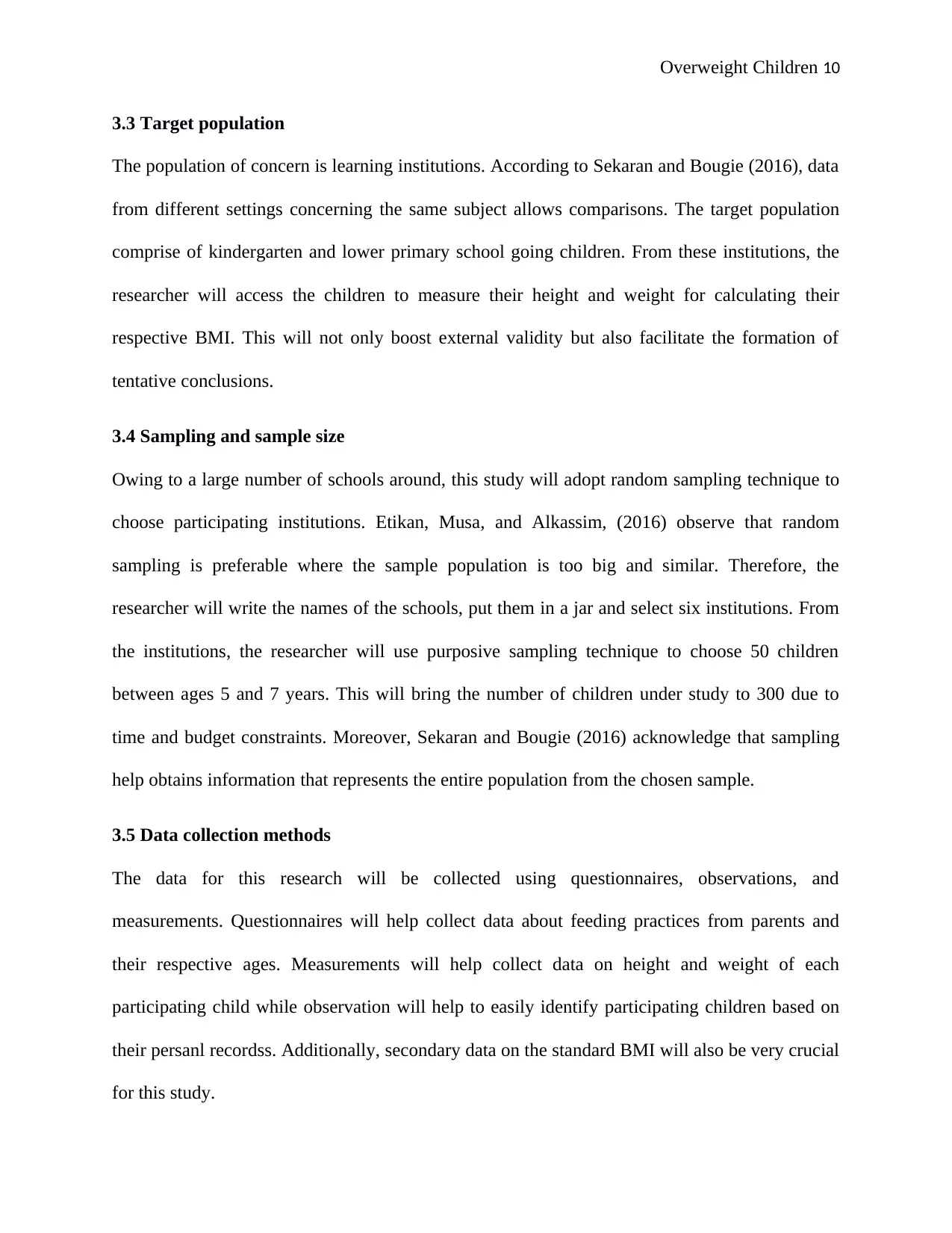
Overweight Children 10
3.3 Target population
The population of concern is learning institutions. According to Sekaran and Bougie (2016), data
from different settings concerning the same subject allows comparisons. The target population
comprise of kindergarten and lower primary school going children. From these institutions, the
researcher will access the children to measure their height and weight for calculating their
respective BMI. This will not only boost external validity but also facilitate the formation of
tentative conclusions.
3.4 Sampling and sample size
Owing to a large number of schools around, this study will adopt random sampling technique to
choose participating institutions. Etikan, Musa, and Alkassim, (2016) observe that random
sampling is preferable where the sample population is too big and similar. Therefore, the
researcher will write the names of the schools, put them in a jar and select six institutions. From
the institutions, the researcher will use purposive sampling technique to choose 50 children
between ages 5 and 7 years. This will bring the number of children under study to 300 due to
time and budget constraints. Moreover, Sekaran and Bougie (2016) acknowledge that sampling
help obtains information that represents the entire population from the chosen sample.
3.5 Data collection methods
The data for this research will be collected using questionnaires, observations, and
measurements. Questionnaires will help collect data about feeding practices from parents and
their respective ages. Measurements will help collect data on height and weight of each
participating child while observation will help to easily identify participating children based on
their persanl recordss. Additionally, secondary data on the standard BMI will also be very crucial
for this study.
3.3 Target population
The population of concern is learning institutions. According to Sekaran and Bougie (2016), data
from different settings concerning the same subject allows comparisons. The target population
comprise of kindergarten and lower primary school going children. From these institutions, the
researcher will access the children to measure their height and weight for calculating their
respective BMI. This will not only boost external validity but also facilitate the formation of
tentative conclusions.
3.4 Sampling and sample size
Owing to a large number of schools around, this study will adopt random sampling technique to
choose participating institutions. Etikan, Musa, and Alkassim, (2016) observe that random
sampling is preferable where the sample population is too big and similar. Therefore, the
researcher will write the names of the schools, put them in a jar and select six institutions. From
the institutions, the researcher will use purposive sampling technique to choose 50 children
between ages 5 and 7 years. This will bring the number of children under study to 300 due to
time and budget constraints. Moreover, Sekaran and Bougie (2016) acknowledge that sampling
help obtains information that represents the entire population from the chosen sample.
3.5 Data collection methods
The data for this research will be collected using questionnaires, observations, and
measurements. Questionnaires will help collect data about feeding practices from parents and
their respective ages. Measurements will help collect data on height and weight of each
participating child while observation will help to easily identify participating children based on
their persanl recordss. Additionally, secondary data on the standard BMI will also be very crucial
for this study.
Paraphrase This Document
Need a fresh take? Get an instant paraphrase of this document with our AI Paraphraser
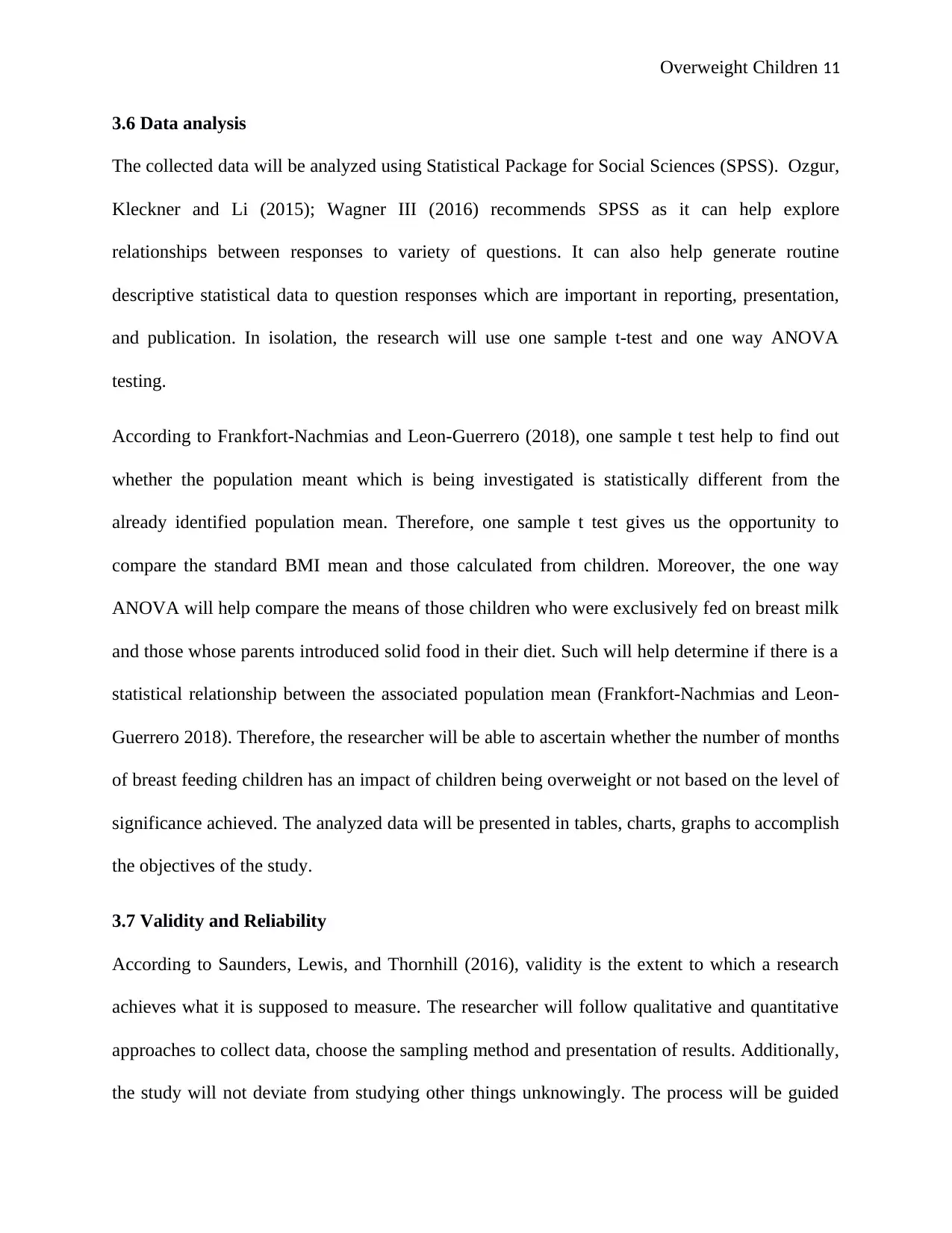
Overweight Children 11
3.6 Data analysis
The collected data will be analyzed using Statistical Package for Social Sciences (SPSS). Ozgur,
Kleckner and Li (2015); Wagner III (2016) recommends SPSS as it can help explore
relationships between responses to variety of questions. It can also help generate routine
descriptive statistical data to question responses which are important in reporting, presentation,
and publication. In isolation, the research will use one sample t-test and one way ANOVA
testing.
According to Frankfort-Nachmias and Leon-Guerrero (2018), one sample t test help to find out
whether the population meant which is being investigated is statistically different from the
already identified population mean. Therefore, one sample t test gives us the opportunity to
compare the standard BMI mean and those calculated from children. Moreover, the one way
ANOVA will help compare the means of those children who were exclusively fed on breast milk
and those whose parents introduced solid food in their diet. Such will help determine if there is a
statistical relationship between the associated population mean (Frankfort-Nachmias and Leon-
Guerrero 2018). Therefore, the researcher will be able to ascertain whether the number of months
of breast feeding children has an impact of children being overweight or not based on the level of
significance achieved. The analyzed data will be presented in tables, charts, graphs to accomplish
the objectives of the study.
3.7 Validity and Reliability
According to Saunders, Lewis, and Thornhill (2016), validity is the extent to which a research
achieves what it is supposed to measure. The researcher will follow qualitative and quantitative
approaches to collect data, choose the sampling method and presentation of results. Additionally,
the study will not deviate from studying other things unknowingly. The process will be guided
3.6 Data analysis
The collected data will be analyzed using Statistical Package for Social Sciences (SPSS). Ozgur,
Kleckner and Li (2015); Wagner III (2016) recommends SPSS as it can help explore
relationships between responses to variety of questions. It can also help generate routine
descriptive statistical data to question responses which are important in reporting, presentation,
and publication. In isolation, the research will use one sample t-test and one way ANOVA
testing.
According to Frankfort-Nachmias and Leon-Guerrero (2018), one sample t test help to find out
whether the population meant which is being investigated is statistically different from the
already identified population mean. Therefore, one sample t test gives us the opportunity to
compare the standard BMI mean and those calculated from children. Moreover, the one way
ANOVA will help compare the means of those children who were exclusively fed on breast milk
and those whose parents introduced solid food in their diet. Such will help determine if there is a
statistical relationship between the associated population mean (Frankfort-Nachmias and Leon-
Guerrero 2018). Therefore, the researcher will be able to ascertain whether the number of months
of breast feeding children has an impact of children being overweight or not based on the level of
significance achieved. The analyzed data will be presented in tables, charts, graphs to accomplish
the objectives of the study.
3.7 Validity and Reliability
According to Saunders, Lewis, and Thornhill (2016), validity is the extent to which a research
achieves what it is supposed to measure. The researcher will follow qualitative and quantitative
approaches to collect data, choose the sampling method and presentation of results. Additionally,
the study will not deviate from studying other things unknowingly. The process will be guided
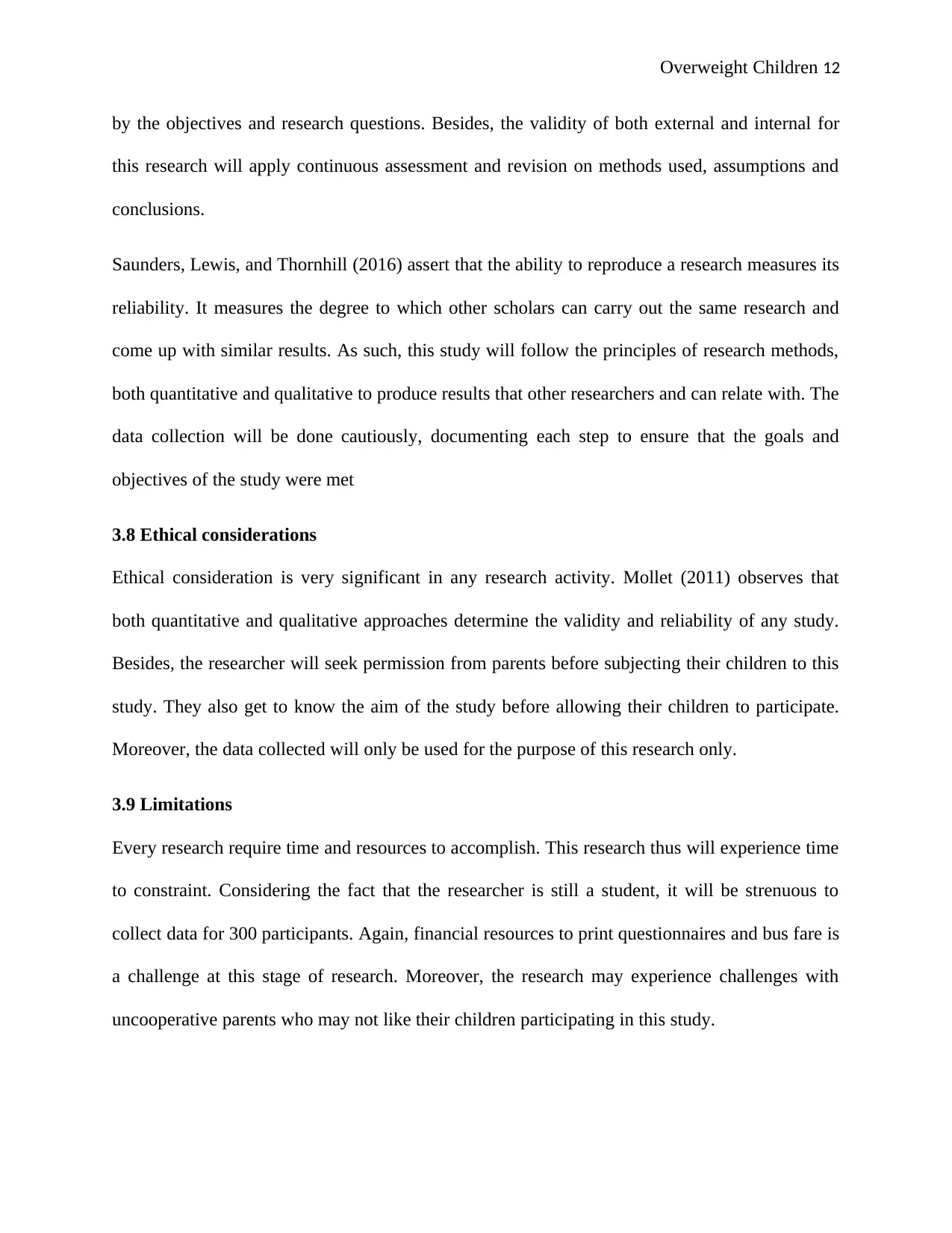
Overweight Children 12
by the objectives and research questions. Besides, the validity of both external and internal for
this research will apply continuous assessment and revision on methods used, assumptions and
conclusions.
Saunders, Lewis, and Thornhill (2016) assert that the ability to reproduce a research measures its
reliability. It measures the degree to which other scholars can carry out the same research and
come up with similar results. As such, this study will follow the principles of research methods,
both quantitative and qualitative to produce results that other researchers and can relate with. The
data collection will be done cautiously, documenting each step to ensure that the goals and
objectives of the study were met
3.8 Ethical considerations
Ethical consideration is very significant in any research activity. Mollet (2011) observes that
both quantitative and qualitative approaches determine the validity and reliability of any study.
Besides, the researcher will seek permission from parents before subjecting their children to this
study. They also get to know the aim of the study before allowing their children to participate.
Moreover, the data collected will only be used for the purpose of this research only.
3.9 Limitations
Every research require time and resources to accomplish. This research thus will experience time
to constraint. Considering the fact that the researcher is still a student, it will be strenuous to
collect data for 300 participants. Again, financial resources to print questionnaires and bus fare is
a challenge at this stage of research. Moreover, the research may experience challenges with
uncooperative parents who may not like their children participating in this study.
by the objectives and research questions. Besides, the validity of both external and internal for
this research will apply continuous assessment and revision on methods used, assumptions and
conclusions.
Saunders, Lewis, and Thornhill (2016) assert that the ability to reproduce a research measures its
reliability. It measures the degree to which other scholars can carry out the same research and
come up with similar results. As such, this study will follow the principles of research methods,
both quantitative and qualitative to produce results that other researchers and can relate with. The
data collection will be done cautiously, documenting each step to ensure that the goals and
objectives of the study were met
3.8 Ethical considerations
Ethical consideration is very significant in any research activity. Mollet (2011) observes that
both quantitative and qualitative approaches determine the validity and reliability of any study.
Besides, the researcher will seek permission from parents before subjecting their children to this
study. They also get to know the aim of the study before allowing their children to participate.
Moreover, the data collected will only be used for the purpose of this research only.
3.9 Limitations
Every research require time and resources to accomplish. This research thus will experience time
to constraint. Considering the fact that the researcher is still a student, it will be strenuous to
collect data for 300 participants. Again, financial resources to print questionnaires and bus fare is
a challenge at this stage of research. Moreover, the research may experience challenges with
uncooperative parents who may not like their children participating in this study.
⊘ This is a preview!⊘
Do you want full access?
Subscribe today to unlock all pages.

Trusted by 1+ million students worldwide
1 out of 27
Related Documents
Your All-in-One AI-Powered Toolkit for Academic Success.
+13062052269
info@desklib.com
Available 24*7 on WhatsApp / Email
![[object Object]](/_next/static/media/star-bottom.7253800d.svg)
Unlock your academic potential
Copyright © 2020–2025 A2Z Services. All Rights Reserved. Developed and managed by ZUCOL.





